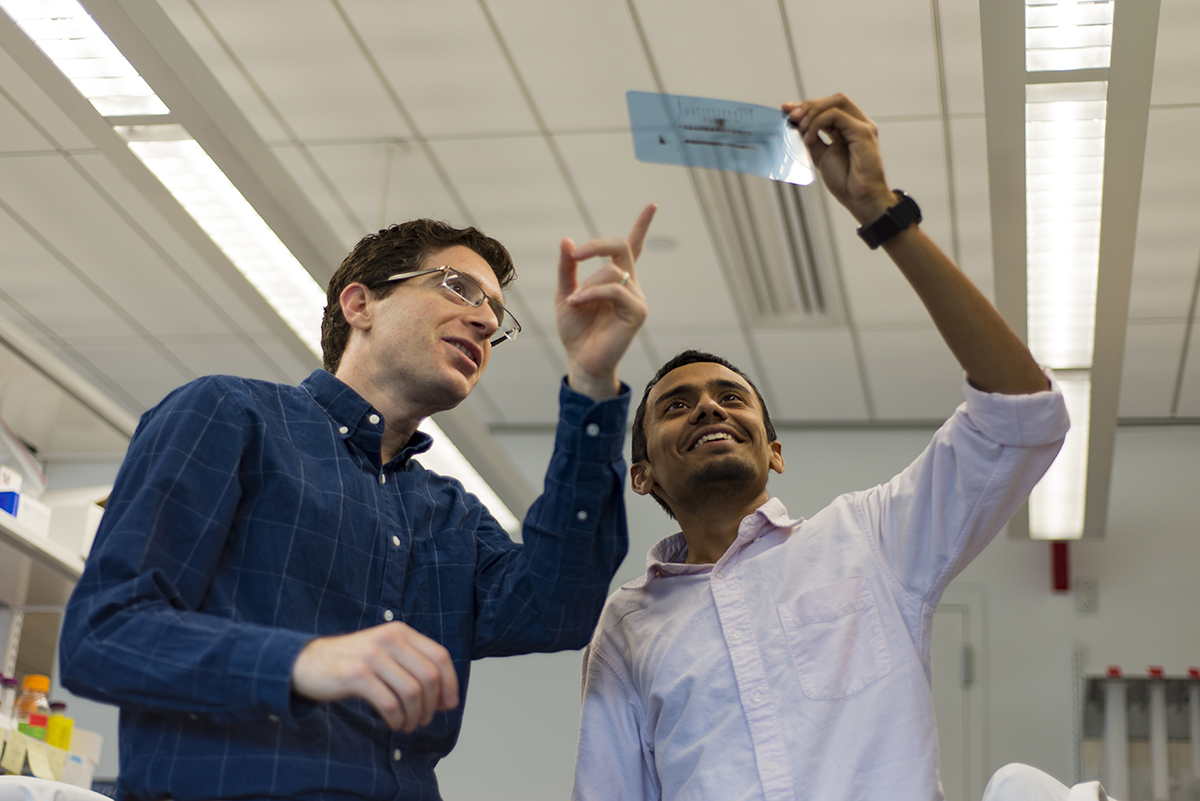Meinig investigator sees lipids as path to curing disease
By Linda B. Glaser

The key to curing multiple sclerosis may well lie in the mysterious signaling of lipids, a major component of cells.
Lipids, which are essentially fat molecules, make up the membranes that form barriers between the inside and outside of a cell and around the organelles inside a cell. Lipids are also critical to signaling within and between cells, messaging that plays important roles in body functions. But lipids are challenging to study using traditional approaches: They’re not easily tagged with DNA-encoded fluorescent probes, as proteins now can be.
In chemist Jeremy Baskin’s lab, new and innovative ways to illuminate and visualize the beginnings of lipid signaling pathways are being developed. “We’re taking advantage of chemical reactions to specifically tag lipids with different kinds of imaging agents, so we can track their behavior within living cells using a fluorescence microscope,” explains Baskin. “We pick components of cells that are hard to tag, so we have to use our ingenuity as chemists to find ways to selectively tag them.”
Baskin was recently appointed a Nancy and Peter Meinig Family Investigator in the Life Sciences, an award that recognizes and supports “outstanding, innovative faculty life sciences research at Cornell.”
“Jeremy is already a leader in an emerging group of young scientists who are bringing expertise in chemistry to address the complicated biology that underlies health and disease,” says Barbara Baird, senior associate dean in the College of Arts and Sciences and the Horace White Professor of Chemistry and Chemical Biology. “His laboratory at Cornell is poised to make exciting discoveries in lipid metabolism as well as make available new tools for discoveries in biomedical research more generally.”
Baskin describes himself as an “interdisciplinary person,” as evidenced by his dual appointments as assistant professor in the Department of Chemistry and Chemical Biology and in the Weill Institute for Cell and Molecular Biology. “My joint position fits really nicely with the research program I’m setting up at Cornell,” he says. “There are projects in my lab that focus on technology development, involving synthesis of chemical probes and pioneering new molecular imaging approaches, and other projects focused more on basic biological discovery, where we’re trying to uncover new functions for lipids inside of the cell.”
Four graduate students and three undergraduates from a range of scientific fields work with Baskin. And although his lab started work less than a year ago, Baskin says they’ve made a lot of progress and are almost ready to submit their first paper.
Baskin first began working with molecular imaging methods as a graduate student in the Department of Chemistry at the University of California, where he developed a chemical reaction called “copper-free click chemistry” and used it to tag sugars on the surfaces of live cells. He then became interested in lipids while a Jane Coffin Childs Postdoctoral Fellow in the Department of Cell Biology at Yale School of Medicine, where he and his colleagues found an unexpected connection between the lipids making up myelin in the brain’s white matter and leukodystrophy diseases, which are rare neurological diseases affecting children that have similarities to multiple sclerosis.
“We discovered that the genetic defect in one leukodystrophy causes loss of a protein which is key to the action of the lipid synthetic pathway,” he explains. “This is exciting because the first step toward therapies for these diseases, which are currently all untreatable, is being able to understand the mechanism of how the disease occurs.” The paper outlining their discovery was published last fall in Nature Cell Biology.
Linda B. Glaser is a staff writer for the College of Arts and Sciences.
Media Contact
Get Cornell news delivered right to your inbox.
Subscribe